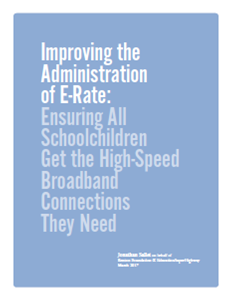Getting the E-Rate to Deliver the High-Speed Broadband Connections Schoolchildren Need
Monday, April 8, 2019
Digital Beat
Getting the E-Rate to Deliver the High-Speed Broadband Connections Schoolchildren Need

Since 1981, the Benton Foundation has fought for a singular goal: to bring open, affordable, high-capacity broadband to all people in the United States to ensure a thriving democracy – and to deliver new opportunities and strengthen communities to bridge our divides.
An important aspect of Benton’s work has focused on schools and libraries. As far back as 1995, Benton published The Learning Connection: Schools in the Information Age, examining how educators were grappling with the difficult interplay of technological change and educational values. We began by reviewing the potential for technology-driven education reform and outlining an agenda for building the human infrastructure of the Information Age by addressing such issues as content, curriculum reform, professional development, assessment, equity, and community involvement.
The following year, thanks to the leadership of Senators Jay Rockefeller (D-WV), Olympia Snowe (R-ME), and Representative Ed Markey (D-MA), President Bill Clinton signed into law the bipartisan Telecommunications Act of 1996, which took the bold step of creating the “E-Rate program” to connect schools and libraries to the internet. The goals of this immensely successful program are just as vital today as the day the Act was signed – helping to connect every school and library to high-speed broadband, every classroom to Wi-Fi, and every student to digital learning opportunities.
When first conceived, just 4% of classrooms had access to the internet. By 1999, 95% of U.S. schools were connected to the internet. But in the 21st century, as broadband’s potential expanded, educators realized that connection speeds had not kept pace, and they needed higher-capacity networks to ensure that every child could take full advantage of the digital learning opportunities now becoming available.
Through reports issued in 2002 and 2003, Benton laid out the critical need for delivering high-capacity broadband to schools and libraries. In 2008, we released An Action Plan for America: Using Technology and Innovation to Address Our Nation's Critical Challenges. This plan called for the creation of a national broadband strategy that among other things would help maximize broadband to transform the way teachers teach and students learn.
Following development of the 2010 National Broadband Plan, which set ambitious connectivity goals for schools and libraries, the FCC took historic action in 2014 to modernize the E-Rate program to provide schools and libraries critical new tools to extend the reach of high-speed broadband, and set ambitious goals to ensure students acquire the speeds they need for digital learning.
With enormous progress being made by the FCC’s E-Rate modernization, it became clear that some schools were nonetheless being left behind. As a result, Benton commissioned Improving the Administration of E-Rate: Ensuring All Schoolchildren Get the High-Speed Broadband Connections They Need to help the FCC make good on the 2014 reforms -- and ensure that every student, regardless of income or geography, had access to the same digital learning opportunities. I want to especially thank EducationSuperHighway for their partnership in this effort.
Because high-speed broadband can be a learning accelerator and opportunity equalizer, ubiquitous access is as important to learning today, as pencils and chalkboard were yesterday. This connectivity can unleash innovation that improves the way teachers, students, and adults prepare to face the opportunities and challenges of a 21st century economy.
Over the past months, Benton been discussing the future of broadband with a broad range of community leaders from around the nation; from state research and education networks in Michigan and California, to local efforts in Colorado, Kansas, Idaho, Maryland, New Mexico, Washington, Tennessee, and Wyoming. We’ve learned about game-changing strategies to improve libraries in Georgia, including with the help of the E-Rate program. We’ve heard about new ways to reach schools, libraries, and other anchor institutions in a county along the California-Mexico border.
Building off these and other insights, in the fall of 2019, Benton will be releasing a compressive and forward-looking new report, A Vision for the 2020s: Access to Broadband in the Next Decade, to offer an agenda for broadband access and availability over the next ten years. The more we talk to state and local leaders, the more we realize that community leadership is a cornerstone to any public-policy agenda. Recognition of the importance of that kind of leadership is critical to the successful administration of the E-Rate program, as it will be critical to meeting the new broadband challenges of the 2020’s.
Adrianne B. Furniss is the Executive Director of the Benton Foundation.
Benton, a non-profit, operating foundation, believes that communication policy - rooted in the values of access, equity, and diversity - has the power to deliver new opportunities and strengthen communities to bridge our divides. Our goal is to bring open, affordable, high-capacity broadband to all people in the U.S. to ensure a thriving democracy.
© Benton Foundation 2019. Redistribution of this email publication - both internally and externally - is encouraged if it includes this copyright statement.
For subscribe/unsubscribe info, please email headlinesATbentonDOTorg







